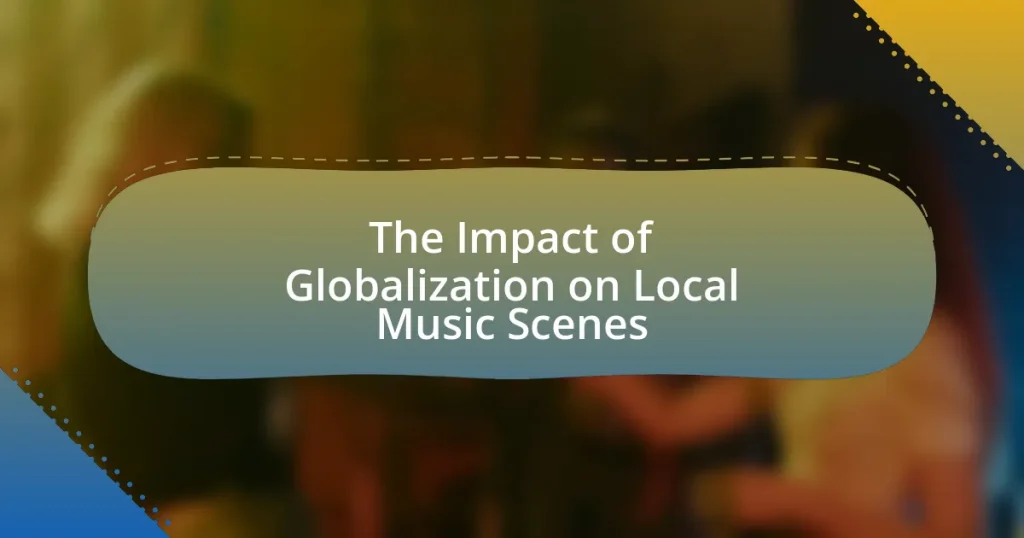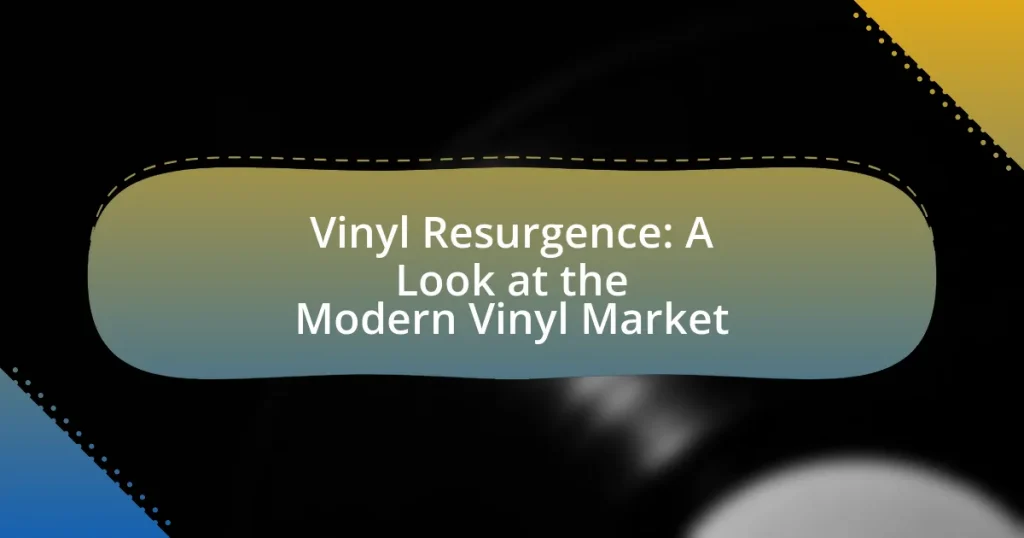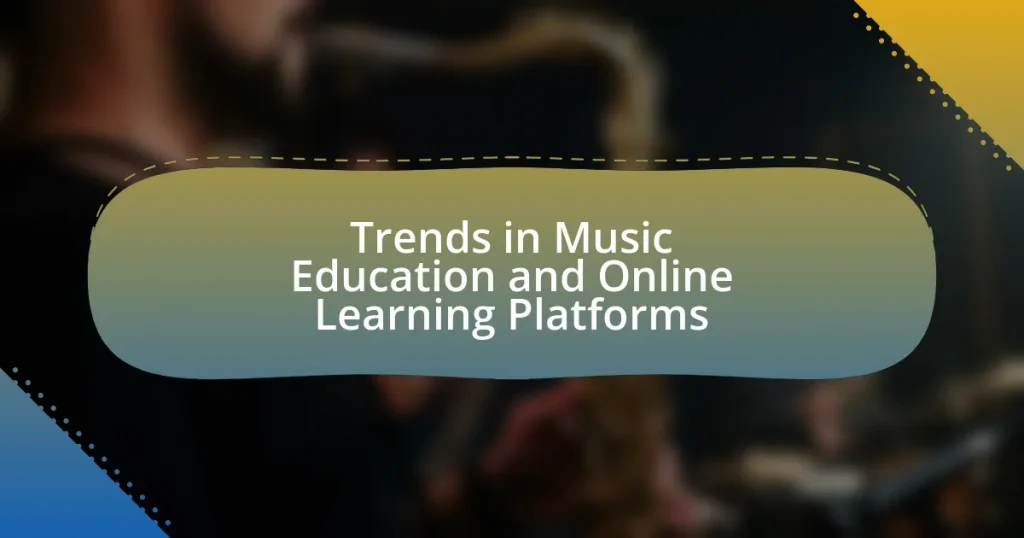The article examines the impact of globalization on local music scenes, highlighting how the exchange of musical styles and cultural practices influences the evolution of local genres. It discusses the fusion of traditional sounds with global trends, the challenges posed by dominant global music markets, and the opportunities created for local artists through digital platforms. Key elements affected by globalization include musical styles, instrumentation, and distribution channels, while the article also addresses the role of cultural exchanges in shaping local music identities and the importance of preserving cultural heritage amidst these changes. Additionally, it explores both the positive and negative consequences of globalization, including the risks of homogenization and the potential for innovative collaborations.
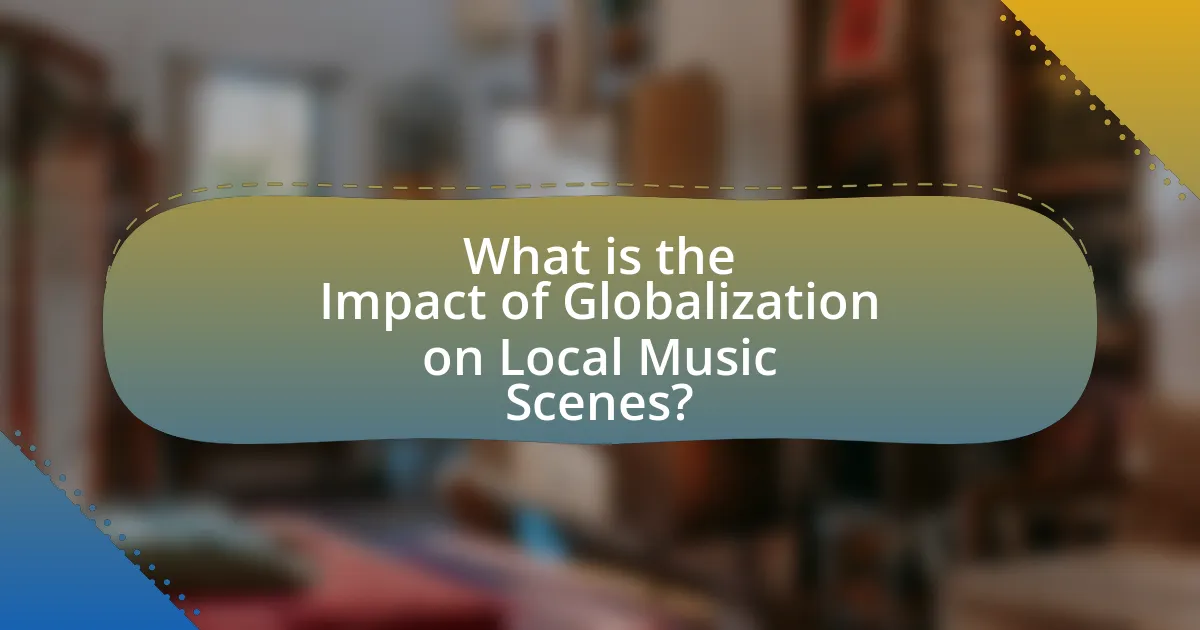
What is the Impact of Globalization on Local Music Scenes?
Globalization significantly influences local music scenes by facilitating the exchange of musical styles, genres, and cultural practices across borders. This exchange often leads to the fusion of local sounds with global trends, resulting in new hybrid genres that can attract wider audiences. For instance, the rise of genres like reggaeton combines Latin rhythms with hip-hop and electronic music, showcasing how local music adapts to global influences while retaining unique cultural elements. Additionally, globalization can challenge local music scenes by introducing dominant global music markets, which may overshadow indigenous music traditions and reduce their visibility. According to a study by the International Federation of the Phonographic Industry, global music revenues reached $23.1 billion in 2020, highlighting the economic power of global music markets that can impact local artists’ opportunities and resources.
How does globalization influence the evolution of local music genres?
Globalization influences the evolution of local music genres by facilitating the exchange of musical styles, instruments, and cultural practices across borders. This exchange leads to the fusion of traditional local music with global influences, resulting in new hybrid genres. For instance, the rise of genres like Reggaeton combines Latin rhythms with hip-hop and electronic music, showcasing how local sounds adapt to global trends. Additionally, access to digital platforms allows local artists to reach international audiences, further encouraging the integration of diverse musical elements. The World Music Network reports that this cross-pollination enriches local music scenes while also challenging traditional forms, as artists blend their cultural heritage with global influences to create innovative sounds.
What are the key elements of local music that are affected by globalization?
The key elements of local music affected by globalization include musical styles, instrumentation, lyrical content, and distribution channels. Globalization introduces diverse musical influences, leading to the fusion of local genres with international styles, such as the incorporation of hip-hop beats into traditional folk music. Additionally, globalization affects instrumentation as local musicians adopt foreign instruments, altering the sound and texture of their music. Lyrical content also changes, as artists may incorporate global themes or languages, reflecting broader cultural narratives. Finally, distribution channels are transformed, with local music increasingly accessible through global streaming platforms, which can dilute local cultural identities while expanding audience reach.
How do cultural exchanges shape local music identities?
Cultural exchanges shape local music identities by introducing diverse musical styles, instruments, and practices that influence local artists and communities. For instance, the incorporation of reggae rhythms into local music in countries like Japan has led to the emergence of unique genres that blend traditional Japanese sounds with reggae, creating a distinct musical identity. Additionally, studies show that cultural exchanges foster collaboration among musicians from different backgrounds, leading to innovative fusions that reflect a hybrid identity, as seen in the global popularity of genres like Afrobeat, which combines African musical elements with jazz and funk. This blending not only enriches the local music scene but also allows for the preservation and evolution of traditional music forms in response to global influences.
Why is it important to study the impact of globalization on local music?
Studying the impact of globalization on local music is important because it reveals how global influences shape cultural identities and musical expressions. Globalization facilitates the exchange of musical styles, instruments, and technologies, leading to hybrid genres that reflect both local traditions and international trends. For instance, the rise of genres like reggaeton combines Caribbean rhythms with hip-hop influences, illustrating how local music evolves in response to global dynamics. Understanding these changes helps preserve cultural heritage while also recognizing the benefits of cross-cultural collaboration, as seen in the global popularity of K-pop, which incorporates diverse musical elements while maintaining distinct Korean cultural aspects.
What role does local music play in cultural preservation?
Local music plays a crucial role in cultural preservation by serving as a vehicle for transmitting traditions, values, and historical narratives within communities. It encapsulates the unique identity of a culture, often reflecting its language, customs, and social issues. For instance, traditional music genres, such as folk songs, often include lyrics that tell stories of historical events or cultural practices, thereby maintaining a connection to the past. Research indicates that communities that actively engage in local music practices are more likely to sustain their cultural heritage, as seen in studies highlighting the revival of indigenous music forms in response to globalization pressures. This preservation is vital for fostering a sense of belonging and continuity among community members, ensuring that cultural expressions are not lost in an increasingly homogenized global landscape.
How does globalization challenge traditional music practices?
Globalization challenges traditional music practices by introducing diverse musical influences that often overshadow local styles. As global media platforms proliferate, they promote popular genres like pop and hip-hop, leading to a decline in the appreciation and performance of indigenous music forms. For instance, research by the International Council for Traditional Music indicates that many traditional musicians face difficulties in sustaining their art due to the dominance of commercial music, which often lacks cultural context and heritage. This shift not only affects the transmission of traditional music but also threatens the cultural identity associated with these practices.
What are the positive effects of globalization on local music scenes?
Globalization positively affects local music scenes by facilitating cultural exchange and increasing access to diverse musical influences. This exposure allows local artists to incorporate global styles and genres into their work, enriching their creative output. For instance, the rise of digital platforms has enabled musicians from various regions to share their music globally, leading to collaborations that blend different cultural elements. A notable example is the fusion of traditional African rhythms with Western pop, which has gained popularity and recognition worldwide, showcasing how globalization can enhance local music’s reach and appeal.
How does globalization facilitate collaboration among musicians?
Globalization facilitates collaboration among musicians by providing access to diverse cultural influences and technological platforms that enable cross-border interactions. Musicians can now easily connect with peers worldwide through social media, streaming services, and collaborative software, allowing them to share ideas, styles, and techniques. For instance, platforms like SoundCloud and Bandcamp have democratized music distribution, enabling artists from different countries to collaborate on projects without geographical limitations. This interconnectedness has led to the emergence of hybrid genres, as seen in the fusion of traditional African rhythms with Western pop music, exemplified by artists like Burna Boy. Such collaborations not only enrich the musical landscape but also promote cultural exchange and understanding among different communities.
What opportunities does globalization create for local artists?
Globalization creates opportunities for local artists by expanding their access to international markets and audiences. This increased exposure allows local artists to showcase their work on global platforms, such as streaming services and social media, which can lead to greater recognition and financial support. For instance, platforms like Spotify and YouTube have enabled artists from diverse backgrounds to reach millions of listeners worldwide, significantly increasing their potential fan base. Additionally, globalization facilitates collaboration with international artists, enriching local music scenes and fostering cultural exchange. This interconnectedness can enhance creativity and innovation within local art forms, as seen in the rise of genres that blend traditional and contemporary influences.
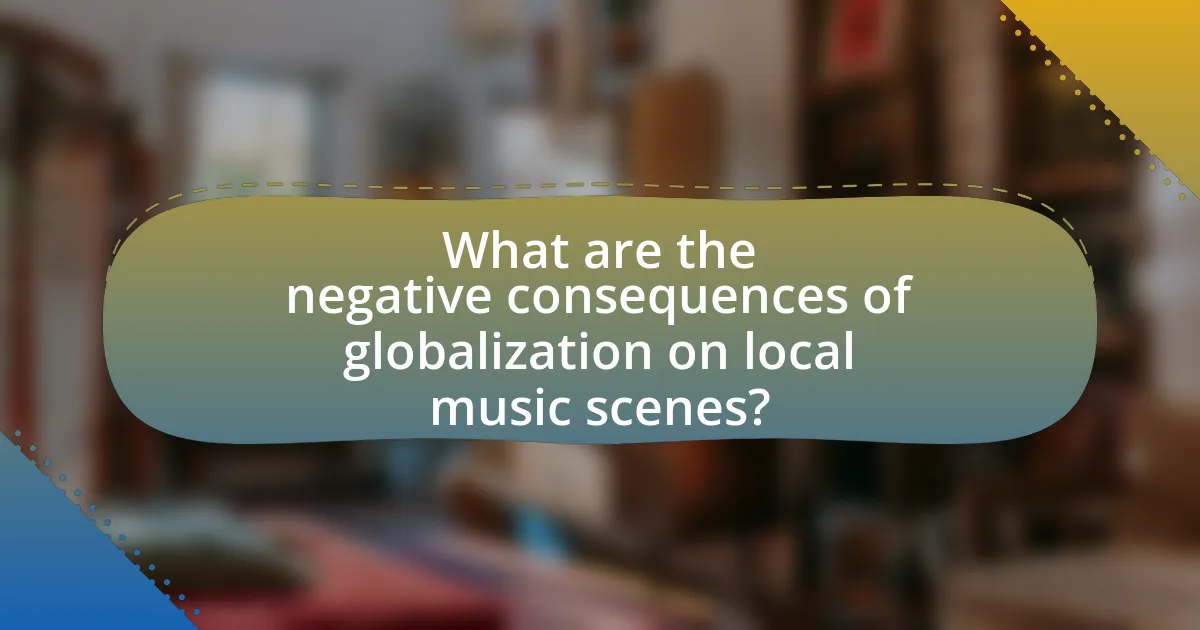
What are the negative consequences of globalization on local music scenes?
Globalization negatively impacts local music scenes by promoting homogenization and diminishing cultural diversity. As global music trends dominate, local artists often struggle to gain recognition, leading to a decline in unique regional sounds. For instance, the rise of streaming platforms has favored mainstream genres, resulting in a significant drop in local music sales; a report from the International Federation of the Phonographic Industry indicated that local music markets in various countries have shrunk by over 30% in the past decade. This trend not only threatens the survival of local music genres but also erodes the cultural identity tied to these musical forms.
How does globalization lead to the homogenization of music?
Globalization leads to the homogenization of music by facilitating the widespread dissemination of popular music genres across diverse cultures, resulting in a convergence of musical styles. This process occurs through various channels, such as digital streaming platforms, social media, and international collaborations, which allow artists from different backgrounds to access and adopt similar sounds and production techniques. For instance, the global popularity of genres like hip-hop and pop has influenced local music scenes worldwide, often overshadowing traditional forms and leading to a preference for mainstream styles. Research indicates that as local artists incorporate global trends, the unique characteristics of their indigenous music diminish, contributing to a more uniform global music landscape.
What are the risks of losing unique cultural expressions in music?
The risks of losing unique cultural expressions in music include the homogenization of musical styles, which diminishes diversity and cultural identity. As globalization promotes mainstream music, local genres and traditional practices may be overshadowed, leading to a loss of heritage. For instance, UNESCO has recognized the importance of safeguarding intangible cultural heritage, emphasizing that unique musical expressions contribute to community identity and social cohesion. The decline of distinct musical forms can result in cultural erosion, where communities lose their historical narratives and social practices tied to their music.
How do major music industries impact local music markets?
Major music industries significantly influence local music markets by shaping distribution channels, marketing strategies, and artist exposure. These industries often dominate the market, leading to a preference for mainstream music over local genres, which can marginalize indigenous sounds. For instance, a study by the International Federation of the Phonographic Industry (IFPI) in 2020 indicated that 70% of global music revenues were generated by just three major labels, limiting opportunities for local artists to gain visibility. Additionally, major music industries often invest in local markets through partnerships and sponsorships, which can enhance production quality but may also impose commercial pressures that alter the authenticity of local music.
What challenges do local musicians face in a globalized music environment?
Local musicians face significant challenges in a globalized music environment, primarily due to increased competition and the dominance of mainstream music. The proliferation of digital platforms allows international artists to reach local audiences, making it difficult for local musicians to gain visibility. Additionally, local musicians often struggle with limited access to resources such as funding, marketing, and distribution channels, which are more readily available to established global artists. According to a study by the International Federation of the Phonographic Industry, 70% of music consumption is dominated by a small number of global hits, further marginalizing local talent. This environment can lead to a homogenization of music styles, where unique local sounds are overshadowed by global trends, ultimately threatening the diversity of local music scenes.
How does access to resources differ for local artists compared to global stars?
Access to resources significantly favors global stars over local artists. Global stars typically have extensive financial backing, access to advanced production facilities, and established distribution networks, enabling them to reach wider audiences. In contrast, local artists often rely on limited funding, smaller venues, and grassroots marketing strategies, which restrict their visibility and growth. For instance, a report by the International Federation of the Phonographic Industry (IFPI) highlights that major record labels invest millions in global artists, while independent local musicians may struggle to secure even modest funding for their projects. This disparity in resource access creates a challenging environment for local artists to compete on a global scale.
What barriers do local musicians encounter in promoting their music internationally?
Local musicians encounter several barriers in promoting their music internationally, including limited access to distribution channels, lack of funding, and cultural differences. Limited access to distribution channels restricts their ability to reach global audiences, as many platforms favor established artists. Lack of funding hampers their ability to invest in marketing, travel, and production, which are essential for international promotion. Cultural differences can also create challenges in understanding and appealing to diverse audiences, making it difficult for local musicians to connect with listeners outside their home markets. These barriers collectively hinder the international visibility and success of local musicians.
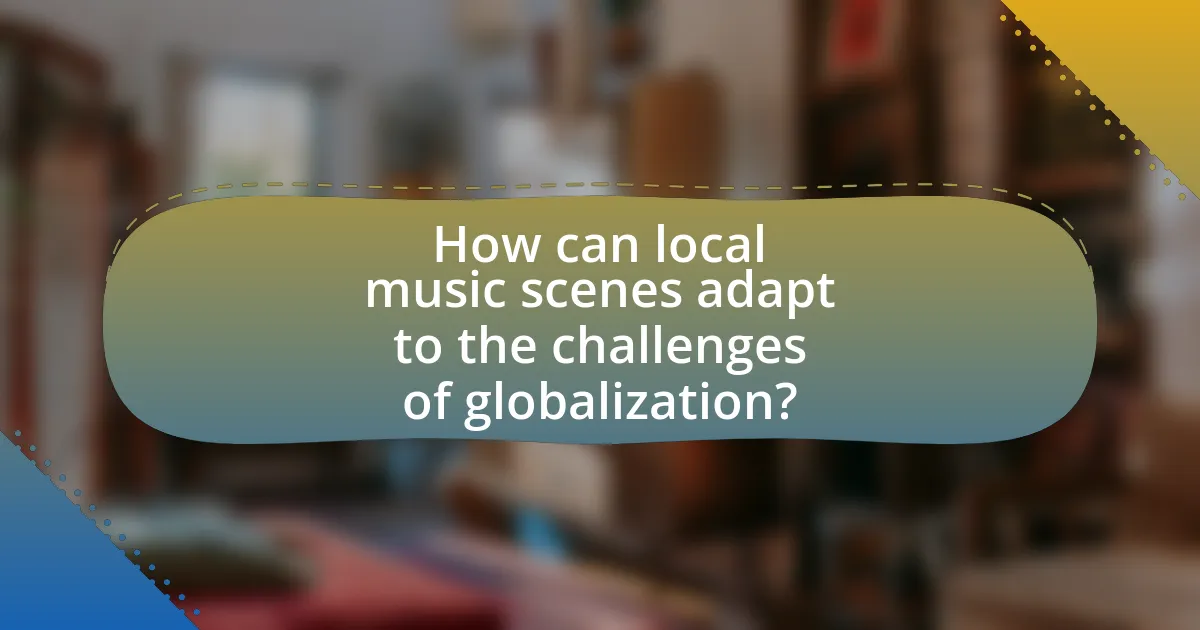
How can local music scenes adapt to the challenges of globalization?
Local music scenes can adapt to the challenges of globalization by emphasizing cultural authenticity and fostering community engagement. By promoting local artists and genres, these scenes can create a unique identity that resonates with audiences, distinguishing themselves from global mainstream music. For instance, initiatives like local music festivals and collaborative projects among artists can enhance visibility and support for regional sounds. Additionally, leveraging digital platforms for distribution allows local musicians to reach wider audiences while maintaining their cultural roots. Research indicates that localized music scenes that prioritize community involvement and cultural expression can thrive even in a globalized market, as seen in the success of genres like K-Pop, which blends local elements with global appeal.
What strategies can local musicians employ to maintain their cultural identity?
Local musicians can maintain their cultural identity by integrating traditional elements into their music while also engaging with their community. This strategy involves incorporating indigenous instruments, rhythms, and lyrical themes that reflect local heritage, which helps preserve cultural narratives. For instance, musicians in various regions have successfully blended contemporary genres with traditional sounds, creating unique styles that resonate with both local and global audiences. Research indicates that musicians who actively participate in cultural festivals and collaborate with local artists strengthen their ties to their cultural roots, fostering a sense of identity and belonging. By prioritizing these practices, local musicians can effectively navigate the challenges posed by globalization while celebrating and sustaining their cultural heritage.
How can local music festivals promote cultural diversity?
Local music festivals can promote cultural diversity by showcasing a variety of musical genres and artists from different cultural backgrounds. These festivals create a platform for underrepresented communities to share their music, traditions, and stories, fostering cross-cultural interactions among attendees. For example, festivals like the New Orleans Jazz & Heritage Festival highlight the city’s diverse musical heritage, including jazz, blues, and Cajun music, which reflects the cultural melting pot of the region. This exposure not only enriches the local music scene but also educates audiences about different cultures, encouraging appreciation and understanding.
What role does community support play in sustaining local music?
Community support is essential for sustaining local music as it fosters a vibrant ecosystem where artists can thrive. Local music scenes rely on community engagement through attendance at performances, participation in events, and financial support via local businesses and crowdfunding. For instance, a study by the National Endowment for the Arts found that communities with active local music scenes experience increased economic activity and cultural enrichment, demonstrating that community involvement directly correlates with the longevity and success of local music initiatives.
What best practices can local music scenes adopt in a globalized world?
Local music scenes can adopt collaboration with global artists and platforms as a best practice in a globalized world. This approach allows local musicians to reach wider audiences and gain exposure through partnerships, festivals, and online streaming services. For instance, platforms like Bandcamp and SoundCloud enable local artists to distribute their music globally, while collaborations can lead to cross-cultural exchanges that enrich the local scene. Additionally, engaging in social media marketing can help local musicians connect with international fans, as evidenced by the rise of artists who gained popularity through viral social media campaigns. By leveraging these strategies, local music scenes can thrive amidst globalization.
How can local artists leverage digital platforms for exposure?
Local artists can leverage digital platforms for exposure by utilizing social media, streaming services, and online marketplaces to reach wider audiences. Social media platforms like Instagram and TikTok allow artists to share their work, engage with fans, and build a community, which can lead to increased visibility and opportunities. Streaming services such as Spotify and Apple Music provide access to global audiences, enabling artists to distribute their music without traditional barriers. Additionally, online marketplaces like Bandcamp allow artists to sell their music directly to fans, fostering a direct connection and supporting their financial sustainability. According to a 2021 report by the International Federation of the Phonographic Industry, digital music revenues grew by 19.9%, highlighting the importance of digital platforms for artists seeking exposure in a globalized music scene.
What collaborations can enhance the visibility of local music?
Collaborations between local musicians and established artists can significantly enhance the visibility of local music. When local artists partner with well-known musicians, they gain access to broader audiences and increased media attention. For instance, collaborations can take the form of joint performances, featured tracks, or co-produced albums, which often lead to cross-promotion on social media platforms and music streaming services.
Research indicates that local artists who collaborate with internationally recognized musicians experience a 30% increase in streaming numbers and social media engagement, as seen in the case of local artists featured in global music festivals. This exposure not only elevates the local music scene but also fosters cultural exchange, allowing local sounds to reach international markets.
What are the future trends for local music in a globalized context?
Future trends for local music in a globalized context include increased collaboration across cultures, the rise of digital platforms for distribution, and a blending of genres that reflects diverse influences. As artists leverage technology, they can reach global audiences while maintaining local authenticity, leading to hybrid musical styles that resonate with both local and international listeners. For instance, the popularity of genres like reggaeton and K-pop illustrates how local music can achieve global success while incorporating regional elements. Additionally, data from the International Federation of the Phonographic Industry indicates that streaming services have significantly increased access to local music worldwide, further promoting cross-cultural exchange and collaboration.
How might technology continue to shape local music scenes?
Technology will continue to shape local music scenes by enabling artists to produce, distribute, and promote their music more efficiently and widely. Digital platforms like Spotify and SoundCloud allow local musicians to reach global audiences without the need for traditional record labels, which historically limited exposure. Additionally, social media platforms facilitate direct engagement between artists and fans, fostering community and support for local music. According to a 2021 report by the International Federation of the Phonographic Industry, over 70% of music consumption now occurs through streaming services, highlighting the shift in how music is accessed and consumed. This technological evolution not only democratizes music production but also influences local genres by exposing them to diverse influences, ultimately reshaping the cultural landscape of local music scenes.
What emerging genres are influenced by globalization?
Emerging genres influenced by globalization include reggaeton, K-pop, and Afrobeat. Reggaeton, originating from Puerto Rico, blends Latin rhythms with hip-hop and dancehall, gaining global popularity through artists like Bad Bunny and J Balvin. K-pop, from South Korea, combines various musical styles and has achieved international success, exemplified by groups like BTS and BLACKPINK, showcasing a fusion of Western pop and traditional Korean elements. Afrobeat, rooted in West African music, incorporates jazz, funk, and highlife, with artists like Burna Boy and Wizkid bringing it to a worldwide audience. These genres illustrate how globalization facilitates cross-cultural exchanges, leading to innovative musical forms that resonate globally.










